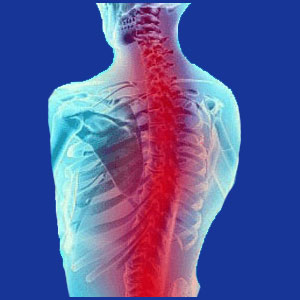
Cervical kyphosis describes a condition in which the usual front-to-back curvature of the neck reverses and faces the wrong direction. The neck typically maintains a conservative lordotic curvature, but many factors can change the degree of this curve for the greater or for the lesser. When the neck goes beyond losing all curvature, and actually begins to curve the opposite way, it is said to have become kyphotic. While changes in cervical lordosis are normal and expected during virtually any lifetime, some alterations in typical curvature can become problematic and even pathological. These are the circumstances that can cause neck pain, as well as a variety of other potentially dire health issues.
This treatise explains kyphotic neck syndrome and the consequences these drastic structural changes can have on the patient’s overall health and wellness.
What is Cervical Kyphosis?
Normally, the neck is lordotic in front-to-back curvature. This describes a condition where the anatomy of the neckdemonstrates a gentle C-shaped curvature, with the open end of the curve pointed towards the posterior of the body. Lordotic curvature is also found in the lumbar region, as well.
Kyphosis describes a curvature wherein the open end of the C-shaped curve faces the anterior of the anatomy. This type of curvature is typically found in the thoracic region, as well as in the sacrococcygeal region. The thoracic kyphosis is the only congenital curvature that is built into the spine. The remaining curves are developmental and occur at various stages of early childhood. So, when discussing a kyphotic neck, we are describing an area of the spinal anatomy that has gone from bending slightly forward, to one that has lost all curvature and eventually reversed direction to bend slightly backward. In essence, the curvature of the neck has changed direction.
Cervical Spinal Curvature Reversal Problems
The human spine is designed to be multiply curved, in order to best support the weight of the body, absorb shock, distribute stresses and balance the anatomy. Each curvature is important and interacts with the curvatures above and below it.
When one front-to-back curvature changes, it will often affect the entire spinal anatomy. Luckily, the spine is flexible and can often accommodate changes in one region, by adjusting curvatures in other regions. This is why many people with conservative to moderate atypical curvatures suffer no pain or neurological consequences whatsoever. However, the body can only acclimate to so much difference, without the potential for pain and nerve symptoms to occur. After all, if the spinal cervical curvature changes, many other structural factors will also change. Some of these resultant anatomical alterations include:
The spinal canal may become less patent and might even suffer central stenosis. Cervical spinal stenosis is the second most commonly experienced variety of narrowing and can produce nightmarish effects in severe instances.
The neuroforamen can become narrowed or closed off due to cervical curvature alterations. This can facilitate the occurrence of single or multiple pinched nerves in the neck.
Pressure on vertebral bodies will change, as will pressure on the intervertebral discs. These factors can increase the chances of suffering injury or escalated deterioration, including compression fractures, intervertebral herniation and osteoarthritic build-up.
Pressure will also change on the spinal joints. This can cause mechanical pain, as well as the escalation of spinal joint deterioration.
When specifically discussing reversal of cervical lordosis into a kyphotic state, some patients suffer spinal instability in the neck that can lead to all of these consequences occurring at the same time. This scenario can create serious health problems for the patient.
Cervical Kyphosis Causes
Changes to the cervical lordosis are very common. However, they are very case-specific, both in their causes and their presentations. Some patients suffer an increase of the lordosis, which is called a hyperlordotic neck. Others suffer a reduction in the lordosis, which is described as a hypolordotic neck. The patients who suffer from the subject of this article demonstrate a reversal of lordosis, which results in a kyphotic neck. Many of the causes and contributors to these changes are similar, or identical, regardless of how the curvature changes. When focusing on cervical kyphosis, some of the leading causes include all of the following circumstances:
Injury can change the anatomy of the actual cervical spine, leading to changes in curvature. This can occur from vertebral or intervertebral traumas, such as fractures, disc ruptures and severe subluxations.
Degeneration affects every human spine and is easily witnessed in the neck after the age of 30, in most people. The discs will desiccate, while the bones and joints will develop arthritic changes. All of these factors might influence spinal curvature.
Spinal ligamentous instability, injury, laxity, ossification or hypertension can all affect curvature. Spinal ligaments work in matched pairs and if one falls out of proper function, the spine might be pulled abnormally in a given direction, changing the curvature.
Likewise, injury or imbalances in the muscular anatomy can literally pull the spine out of alignment and alter the normal curvature in any region. This occurrence can be a cause of spinal lordotic changes, but can also be a consequence. This makes proper diagnosis a very difficult challenge for even expert physicians.
Congenital or developmental changes in the spinal anatomy can lead to direct changes in curvature or the predisposition to develop abnormal curvatures later in life. Some of these scenarios can be explained, while others might be idiopathic in nature.
Atypical Lordosis and Kyphosis Evaluation
Just because the neck has become kyphotic does not mean that major health problems will result. However, kyphosis in the cervical spine is certainly a potentially serious condition that should be monitored by a doctor and treated, if necessary.
The factors that influence the degree of pathology in a reversal of lordosis include the underlying causation and the degree of structural change. After all, minor reversals are not much worse than hypolordotic conditions and many of these can remain essentially symptom-free, although they might considerably increase the patient’s fragility and susceptibility to trauma in the neck.
Muscular spasms that enact cervical kyphotic changes are usually transitory, with the spine returning to normal or near-normal curvature after the cessation of the gripping contractions.
Skeletal reasons for neck kyphosis will rarely resolve by themselves and statistically have the greatest need for drastic treatment. Unfortunately, the therapies used are often risky and barbaric, including hardware-assisted spinal fusion over multiple vertebral levels.
Before seeking any dramatic care for cervical loss of lordosis, be sure to get several opinions to confirm the condition as the actual source of pain, as well as several opinions on the best course of action regarding treatment.
Neck Pain > Cervical Spinal Lordosis > Cervical Kyphosis






